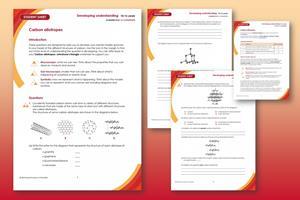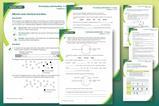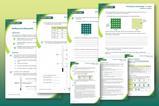Support your learners to develop mental models and deepen understanding of carbon allotropes
-

Download this
Developing understanding worksheet, for age range 14–16
A ramped worksheet to help learners develop their mental models of carbon allotropes. With icons to indicate the conceptual level/s of each question. Answers and guidance are found in the teacher notes.
View and download more Developing understanding worksheets
Learning objectives
- Recall the structure of different allotropes of carbon.
- Explain why carbon can form different giant structures.
- Explain why diamond does not conduct electricity but graphite does.
How to use this resource
- When to use? Use after initial teaching or discussion of this topic to develop ideas further. You can also use as a revision activity.
- Group size? Suitable for independent work either in class or at home. Or use the questions for group or class discussions.
- How long? 15–30 mins
Johnstone’s triangle
Johnstone’s triangle is a model of the three different conceptual levels in chemistry: macroscopic, symbolic and sub-microscopic. You can use Johnstone’s triangle to build a secure understanding of chemical ideas for your learners.
Introduce learners to Johnstone’s triangle with our Carbon allotropes Johnstone’s triangle worksheet which guides learners to think about the similarities and differences between graphite and diamond at a macroscopic, sub-microscopic and symbolic level.
Further reading
Read more about how to use Johnstone’s triangle in your teaching with these articles:
- Develop deeper understanding with models
- Improve students’ understanding with Johnstone’s triangle
- Practical ideas for using Johnstone’s triangle
Norman Reid’s book The Johnstone Triangle: The Key to Understanding Chemistry provides an more in-depth overview, the first chapter is available to read online.
Johnstone’s triangle and this resource
The icons in the margin indicate which level of understanding each question is developing to help prompt learners in their thinking.
- Macroscopic: what we can see. Think about the properties that we can observe, measure and record.
- Sub-microscopic: smaller than we can see. Think about the particle or atomic level.
- Symbolic: representations. Think about how we represent chemical ideas including symbols and diagrams.
The levels are interrelated, for example, learners need visual representation of the sub-microscopic in order to develop mental models of the particle or atomic level. Our approach has been to apply icons to questions based on what the learners should be thinking about.
Questions may be marked with two or all three icons, indicating that learners will be thinking at more than one level. However, individual parts of the question may require learners to think about only one or two specific levels at a time.
Support
This worksheet is ramped so that the earlier questions are more accessible. The activity becomes more challenging in the later questions. You can give extra explanations for the more challenging questions. If completing as an in-class activity it is best to pause and check understanding at intervals, as often one question builds on the previous one.
It is useful for learners to observe macroscopic properties first-hand. You could circulate examples of substances in the classroom, run a class practical of a chemical reaction or show a teacher demonstration of properties.
Give learners physical models to use and manipulate, such as a Molymod™ kits or counters.
Additional support may be needed for any learners still lacking in confidence in the required symbolic representation, for example by sharing and explaining a diagram or a simulation that can show movement of the particles.
Answers and guidance
Download the teacher notes to find the answers to the student worksheet.
There are three multi-part questions in the student worksheet. The first question supports learners to recognise, interpret and evaluate typical diagrams representing the sub-microscopic structure of different allotropes of carbon. Question two guides learners to use dot-and-cross diagrams to explain why carbon can form giant structures. The final question challenges learners’ thinking about a diagram of the structure of diamond by making links to atomic structure. Learners are then asked to use this thinking to explain macroscopic properties of diamond and graphite.
Downloads
Carbon allotropes developing understanding student worksheet
Handout | PDF, Size 0.35 mbCarbon allotropes developing understanding teacher notes and answers
Handout | PDF, Size 0.22 mbCarbon allotropes developing understanding student worksheet
Editable handout | Word, Size 1.24 mbCarbon allotropes developing understanding teacher notes and answers
Editable handout | Word, Size 0.56 mb










































No comments yet